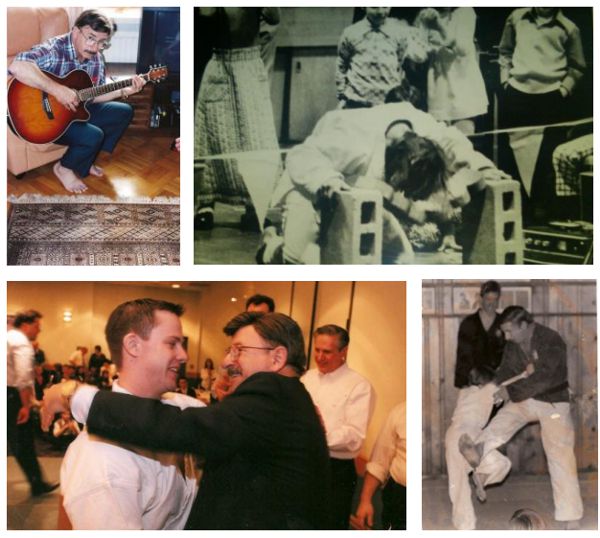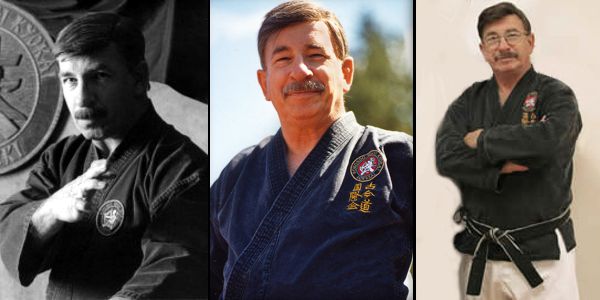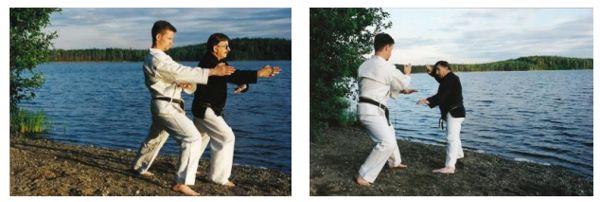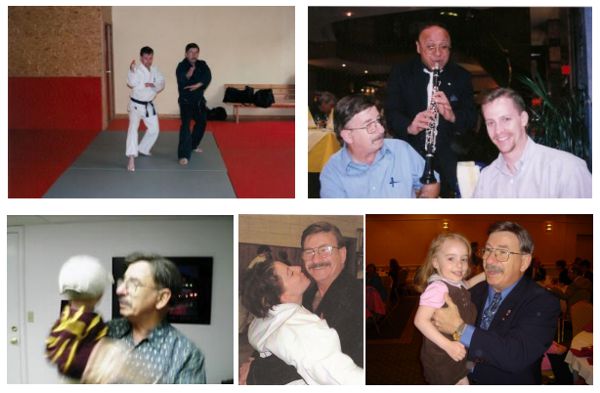Paul Arel
November 12, 1935 – January 2, 2009
A dynamic force passed from this existence, and families and communities are mourning the loss. It is common when a person who is revered in life passes away, that they are placed on a pedestal of unattainable heights. It is also common when the nature of a relationship changes, for selective memory to inhibit recollection of a rich history and cherished moments. Avoiding these traps, I reflect on my Sensei and friend through our personal relationship spanning more than three decades.
As I recalled at the gala celebration of Mr. Arel’s 50th anniversary in budo, my journey with him began in a church dojo in Wethersfield, Conneticut. It was a class of young children, which I had been attending as a spectator, before pleading to be accepted as a student (reminiscent of a young Paul Arel begging Sudo Sensei to teach him). Toward the end of class, Mr. Arel took the kids out to the back porch to do tameshi wari as a treat. Once the kids had broken, Mr. Arel placed a cement block across the supports and proceeded to daintily fold a handkerchief, which he centered on the cement. With a startling kiai he demolished the cement using atama tsuki (head strike) and secured my passion for the arts.
Mr. Arel cultivated one’s pride to be a student of the founder, especially if you were fortunate enough to train at Honbu. The opportunities took on greater significance when we arrived early with the goods from 7-11, and began to have discussions that were not for the class, but sometimes yielded stories and insights that belonged in the dojo. As the techniques became more advanced, new occasions to train were made available. I’m flooded with memories of technique and spirit from afternoon classes, advanced jujitsu before the evening class, all dojo invitational classes, outdoor classes in the backyard (where I had my earliest intensive exposure to Master Dunne and Master Longo), and eventually to the adult karate class where doing even the most basic techniques side by side with Shihan Arel was a privilege to be soaked up and examined. As a frequent uki, I was able to experience very advanced and more obscure techniques, and afforded an implied permission to inquire about them –having been on the receiving end already. My training experiences culminated with the honor of private lessons in his home and mine, and came full circle to the early Honbu days of conversations over coffee – as we’d start with coffee, train in the dojo, basement, or garage, and share stories and laughs while playing the marathon pool game “500”, a Paul Arel creation.
The special connection Daniel and I shared with Mr. Arel was most evident on road trips with all three of us. Driving to a summer camp in upstate New York in Dan’s new car, we made a pit stop at a Burger King. Then Mr. Arel ordered a coffee, and thinking of his new cloth seats, Dan tried to insist we had plenty of time to drink the coffee there. Mr. Arel wanted to get back on the road and was first into the car…at which point Dan and I looked in to find Mr. Arel wiping the seat with some napkins.
Syracuse was a keeper too. After teaching and testing the Syracuse dojo, we took the long ride back home. I convinced Mr. Arel to let me drive (another story entirely) while Dan slept in the back. In the front we were talking about the economy, but when we pulled in to a rest stop and Dan woke up, Mr. Arel seamlessly and convincingly said, “and that’s the story of the time I beat up Oyama”. We kept Dan going with that the whole ride home.
Our friendship blossomed when Teressa and I got married. Always with the warmest embrace, when Mr. Arel hugged Teressa it appeared to me that his world stopped and his attention was completely focused. Dating for six years and with Teressa training before that, we socialized often with the Arels, but getting married and having a place of our own provided a venue for us to host and reciprocate for all the times we’d been guests. The Arels were always up for a meal, just coffee desert and conversation, and of course a suggestion of the casino required no arm-twisting.
Thanks to Vesa and our gracious members in Finland, I enjoyed five trips to Europe traveling, teaching, and bonding with my Sensei. Usually with some excursion, these trips took us to Germany, Estonia, Sweden, Denmark, and Belgium. Sometimes the simplest things leave a lasting impression – I recall his response to the customs agent when asked the nature of our relationship, he simply said “we’re friends”. He was most relaxed when traveling, and open to discussions about his family, martial arts, and his military service. He didn’t travel with a parachute, so indulging me for a while was probably the surer way to get some rest on the flight overseas. I felt honored when a number of times he stated that he never before shared certain information.

During our first trip to Finland, the senior dans took me out for a few beers. They were starting to know Shihan, but they wanted to know about Mr. Arel the man, the regular person, and his lighter side. So I entertained them with the Burger King coffee spill and a few other similar stories. We trained for the week in Vantaa and drove up to Errikkela for the seminar. The first morning in the cafeteria I was sitting with the Finnish instructors, Mr. Arel came over to sit down and as he lowered his tray to the table we all saw a bunch of napkins saturated with spilled coffee – the table erupted except for me. Mr. Arel asked me “what’s so funny” and I said it must be Finnish humor – he thought for a moment, didn’t buy my line, and punched me hard in the arm.
A respected American pioneer of martial arts, I’I’ve always been proud to introduce myself as a student of Paul Arel. Gosei Yamaguchi, son of Gogen, had little interest in us at his dojo in San Fransico until Dan mentioned San Kata (the style Mr. Arel studied under Ishikawa) – this clearly sparked Yamaguchi’s interest and was the key to having a rare conversation. When I introduced myself to Maung Gyi at a Bando tournament in Glastonbury he said, “Paul Arel, toughest karate instructor I know”. Gary Alexander clearly respected Mr. Arel, as they bonded over the Marines, training in the old days, and their IsshinRyu sensei Don Nagle at Nagle’s funeral in NJ to which we took Mr. Arel. I sprinted several blocks after a business dinner in Manhattan one night for the chance to speak with TaeKwondo master Henry Cho about the First North American Karate Tournament and the Johnny Carson Show with Mas Oyama. Though Hidetaka Nishiyama, who passed away in November, did not recall Mr. Arel from the Manhattan Center tournament, Mr. Arel was as excited as I ever heard him when I called from California to say I met him. I was driving in LA when I called Mr. Arel, he was just sitting down to brunch with Sue. He was politely excusing himself by asking if I could call back at a better time. I said sure, and that I was just calling from California to let him know about meeting Nishiyama…I couldn’t see his face but his voice sounded as eager as Dan’s was to hear the Oyama story! Mr. Arel leapt out of the seat and found a quieter spot where he asked to hear every detail.
A singular talent with a unique background, Mr. Arel was able to create and capitalize on rare opportunities to enhance his knowledge of martial arts. His abilities with applied arts seemed to influence his creativity on the mat. Early in my training I was captivated by his demonstrations, and later realized that there was no arrogance in his approach and no superfluous movement. A favorite sequence captures this precisely; he would use a kogaeshi nage (or a variety of other throws), employ osae waza (a plethora of controlling techniques), start to help the uki up – then swiftly take the uki back down, switching hands behind his back, and return to a kensetsu waza. At a glance it just looked impressive, upon examination (and from the uki’s perspective) the kime was exceptional – it hurt in the moment but never after the release, and just when you thought you were free to re-attack, you were immobilized. His technique was a consistent example of Jigoro Kano’s maxim “jita-kyoe” (mutual welfare and benefit).

It was far more likely that he would demonstrate his feelings with a gesture rather than articulate them verbally. One of his most touching gestures was giving me his entire collection of samurai swords, including the first one given to him by Sue Arel, also a Japanese soldier sword, and others he displayed in his home. As if that wasn’t enough of an honor, he came to my home and work more than once with additional swords saying he’d found them in a drawer or closet and I must take them as part of the collection.
While he seemed to be larger than life, his personal constraints were quite human. His pride at times hindered communication and prevented him from resolving issues with his closest friends and most senior students. While outwardly exuding power and confidence, Shihan appeared to need the reassurance of compliance and an implicit guarantee that his decisions would not be opposed. I trusted his wisdom gained through experience, and was privileged that he welcomed my opinions as a sensei, director, and eventually a master in his system. As he began actively preparing for the future of the association, I had growing concerns regarding the implementation of new policies which I considered not to be representative of the ethics and values of our traditional roots, and I tried to share this with him.
In May 2008, he called me at home very emotional, like I’d never heard from him before. He apologized for not responding to any of my e-mails which addressed the relevant political issues, stating that he just wasn’t up to replying. He went on to say that his reason for calling was not to discuss those topics, but to say, while choking back the tears, that he loves me (like a father), values the years of friendship, and appreciates the remarkable 30 plus years of loyalty to him and dedication to his system. He acknowledged how out of character these statements were, and didn’t elaborate on the purpose. I made my peace through that conversation with what had transpired and with what was to come.
During the final director’s meeting in Oct. 2008, Shihan made it clear that no further dialogue about new or preexisting issues was welcome. He made reference to the IKA and emphasized that it was not a system of one style but rather two distinct arts. Ironically, while declining to engage in any discussion, I believe he was subconciously trying to impart some final advice to us as our sensei…’Create a system and be sure to have two distinct arts represented’. This would be the final lesson he gave us. As was always his directive, we took his comments as though they were intended for us, and set a new course which is respectful of it’s roots and guided by integrity.
In several performances over the years, I portrayed a young Paul Arel in his father’s diner, entering the Marine Corps, and the tournament days. As life sometimes imitates art, there are some parallels with the founding of the Kokondo and Seirenkai systems. I believe that the Paul Arel I have attempted to capture in this tribute would be proud of the path we are traveling. Fortunate is the person who can honestly accept life’s disappointments, while recalling with clarity and gratitude the joys that result from opportunity and privilege. More than thirty years of primarily exceptional memories will remain my lasting impressions. I studied intently every nuance of the way he moved down to the details of how he tied his belt. Now each time that I tie
my own he is in my thoughts. I will miss my friend and remain grateful as I reflect on the man I called Sensei.
Written January 2, 2009
By Scott Cohen




